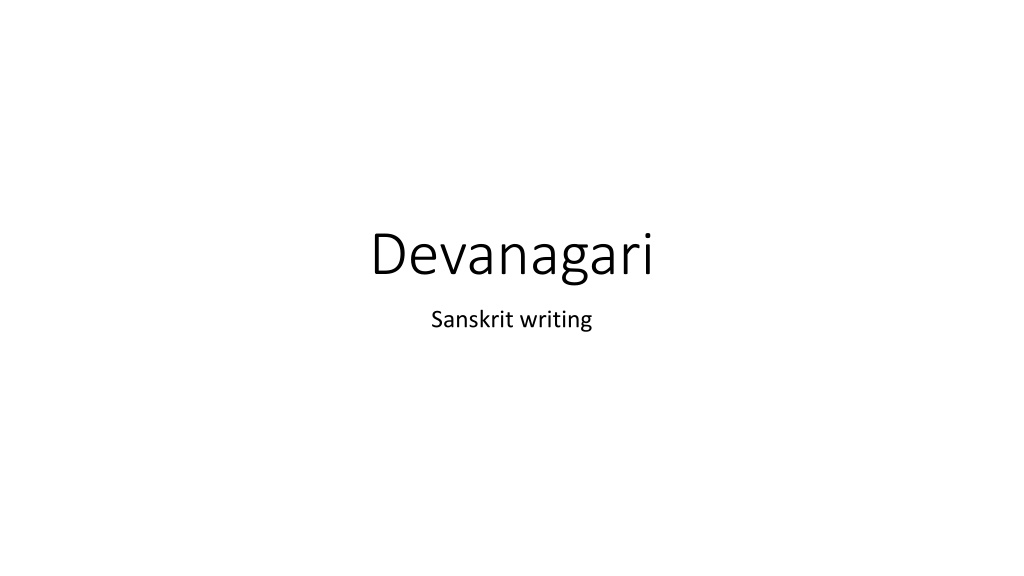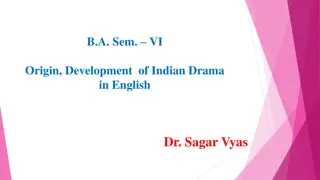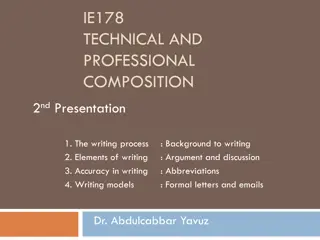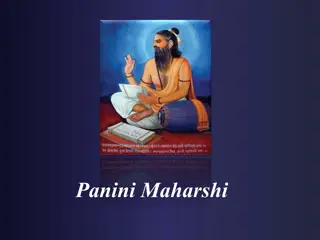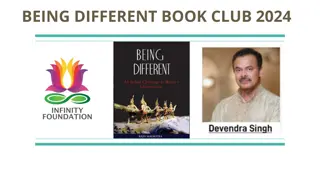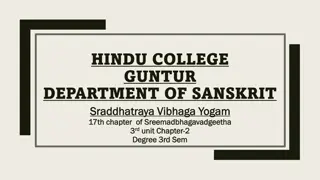Understanding Devanagari Sanskrit Writing System
Explore the beauty and complexity of the Devanagari writing system used for Sanskrit and other Indic languages. Learn about its unique order of letters, aspirates, phonemes, and intricate vowel structures. Discover why Devanagari is a fascinating script to study and appreciate.
Download Presentation

Please find below an Image/Link to download the presentation.
The content on the website is provided AS IS for your information and personal use only. It may not be sold, licensed, or shared on other websites without obtaining consent from the author. Download presentation by click this link. If you encounter any issues during the download, it is possible that the publisher has removed the file from their server.
E N D
Presentation Transcript
Devanagari Sanskrit writing
Why? Andrea was lamenting that we aren t doing or even seeing any Devanagari, the writing system for most Indic languages. So, since Colton and I are trying to learn it, and Andrea has got some under her belt, I made up a little powerpoint about it. It s not really anything compared even to the Wikipedia article about Devanagari, but maybe you ll enjoy it.
Some facts The name of the writing system used for Sanskrit is Devanagari It s beautiful. The name comes from "deva" ( divine ) and "n gar " ( city ). Devanagari is an abugida , which means that all the consonant symbols automatically have a default vowel attached to them: it s usually written as an a in English (the sound that occurs in e.g. dharma or karma ). But sometimes, another vowel is needed, in which case there is a symbol for that vowel.
The order of the letters One of the coolest things about Devanagari is that the consonants are all put into a predictable order, from back of the mouth to the front (top of chart to bottom), and from voiceless to voiceless aspirates to voiced to voiced aspirates (left to right on chart). Starting with the back of the mouth, first come the gutturals ka, kha, ga, gha, nga, ha Then move forward in the mouth to the palatals ca (as in chat), cha, ja, jha, nya, ya, sha (as in shush ) Then move forward to the retroflex (aka cerebral or cacuminal: front of roof of mouth)) a, ha, a, ha, a, ra, a (as in sheesh say ditty and then pull your tongue back about inch from that position and almost touch it to the roof of your mouth and say ditty like that and you are pronouncing retroflex consonants, approximately. Then forward to the dentals ta, tha, da, dha, na, la, sa Then forward to the labials pa, pha, ba, bha, ma, va
Phonemes So you can see that in Devanagari, there are a lot of aspirates that make for separate phonemes where English has very few. Also, note that there are two sh s: the one made when you say shush and the one in sheesh : you can feel how you change your mouth to make the different ones. You may think it s just the vowel that does that, but it s actually not so simple: those are two different phonemes in Sanskrit. The retroflexes? I m sure we use them in English, but they re not phonemes for us, so we haven t got brains built to easily recognize and sort them out.
Vowels Yeah, with the vowels, things start to get loopy to my mind, because of my prejudices, but I can t see it as systematic. There are always at least two ways to write any given vowel, and some are even more complex. For example, the short and long i: If you want to write /bindi/ the word for that little mark between the eyes that a lot of Hindus have, you write Look at that closely: the order of the letters is short i, b, m (the dot), d, long i. So a short i precedes the letter it is pronounced after. That would be fine if all the short vowels are done that way, but no, they are not. That s the only letter that is put before the letter it is pronounced after. Now, if you want to write an i on its own, or at the start of a word, you have to use , which looks nothing like /bi/ that first letter that is the short i. Back to the n in bindi: it is written as a dot above the line, but there is a letter for it, so it could have been written with a letter hanging down below the line. So there are two ways to write it. The same goes for /h/. Lots of little idiosyncrasies. It doesn t get any better from there. In any case, I hope you will agree that if one were to judge it in terms of how it looks, Devanagari is quite beautiful, just as Chinese ideograms are.
If you want more As always, Wikipedia is a good source for this kind of basic, just-the- facts matter. If you want to write your name, or an approximation thereof, in Sanskrit, ask Andrea, or Colton, or me, and we can send it to you, or go to Wikipedia and see how you fare.
Interesting dinner table conversation I ve tried to explain the sounds of Sanskrit to my family, as I try to learn those sounds. First off, I know for a fact that I cannot pronounce many of them accurately. So I explained to them that in Sanskrit, da, dha, a, and ha are four completely different sounds, but they are all closest to one single English phoneme, /d/, and that s what they all sound like when I try to pronounce them. So English speakers are really at a disadvantage in terms of producing and distinguishing Sanskrit sounds. Now it s a running joke in my family that papa thinks there s a difference between duh, duh, duh, and duh, DUH! Which is built upon a previous family joke: I used to make fun of my father (a naturalized US citizen from France) for saying duh instead of the, so I d say Pass duh, duh, duh peas, please or things like that to get his goat a little. I suppose all of that is minorly insensitive, but you can t hear the affection, interest, and humor behind it all. It s just another way of saying that maybe as non-native PIE speakers, we shouldn t worry about how to pronounce the laryngeals. Just leave it looking like math and revel in the phonemic diversity.
